With feathers that look hand-painted by an artist and a presence as elusive as it is enchanting, the Painted Bunting (Passerina ciris) is a living jewel of North America. Often hailed as the most colorful songbird on the continent, this dazzling creature stirs excitement wherever it appears—if you’re lucky enough to spot one. From their bold breeding plumage to their secretive habits and long migratory journeys, Painted Buntings are full of surprises. Here are 15 captivating facts that will draw you deeper into the vibrant world of this extraordinary bird.
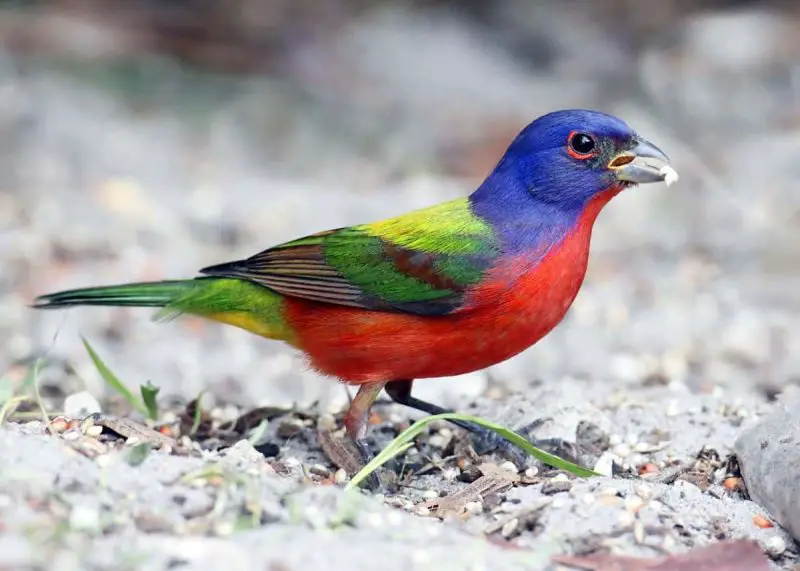
1. Painted Buntings Are Nature’s Living Rainbows
The Male’s Feathers Look Too Beautiful to Be Real
If ever a bird looked like it leapt from the pages of a fairytale, it’s the male Painted Bunting. With a vivid royal-blue head, fiery red underparts, and a back painted in electric green, this little songbird seems almost too colorful to exist in nature. The colors don’t just pop—they shimmer, shift, and dazzle in sunlight, earning the species its well-deserved reputation as North America’s most striking bird. No filters, no exaggeration—just pure, living color that leaves birdwatchers breathless.
2. Females Are Beautiful in Their Own Way
Soft Greens Built for Stealth and Survival
While males steal the spotlight with their rainbow hues, female Painted Buntings embody a quieter kind of beauty. Cloaked in soft olive-green and gentle yellow tones, they blend seamlessly into the leafy underbrush—a natural camouflage perfectly suited for nesting. This subtle plumage isn’t just elegant; it’s essential. It allows females to remain hidden from predators while caring for their young, proving that in the wild, understated beauty can be a powerful shield.
3. They Belong to the Cardinal Family
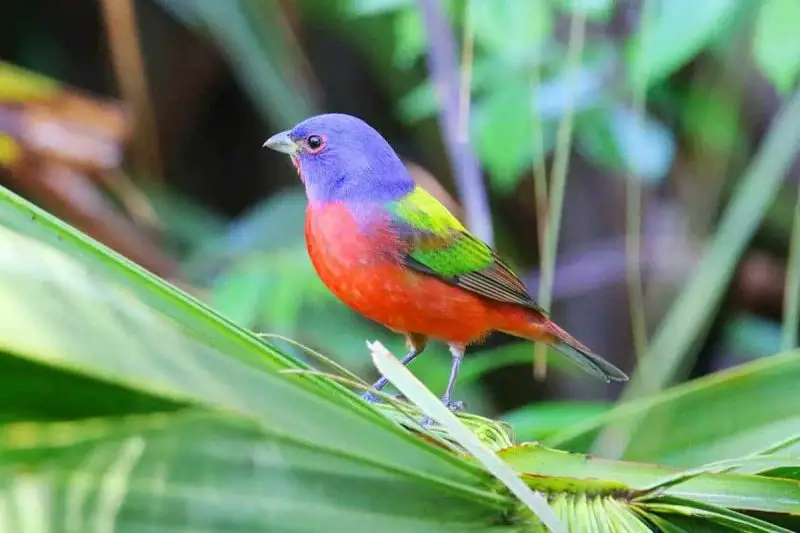
More Cardinal Than Finch—Looks Can Be Deceiving
At first glance, Painted Buntings might seem like brightly colored finches, but their true family ties tell a different story. They are members of the Cardinalidae family, making them close cousins of Northern Cardinals, grosbeaks, and tanagers. Like their relatives, they sport strong, conical beaks—perfect for cracking seeds—and share similar vocal traits and nesting behaviors. So while their petite size and vivid feathers may suggest finch, their DNA and habits reveal a deeper kinship with some of North America’s most beloved songbirds.
4. They Are Found in Two Main U.S. Populations
A Tale of Two Coasts: East Meets West
Painted Buntings may be widespread, but their breeding populations in the U.S. are surprisingly split in two. One group makes its summer home along the southeastern coast, from North Carolina down through Florida’s barrier islands. The other thrives in the inland woodlands and scrublands of Texas, Oklahoma, Arkansas, and Louisiana. Though separated by geography, both populations follow similar migratory rhythms—heading south in winter and returning to their chosen regions each spring in a quiet burst of color and song.
5. They Migrate Long Distances Each Year
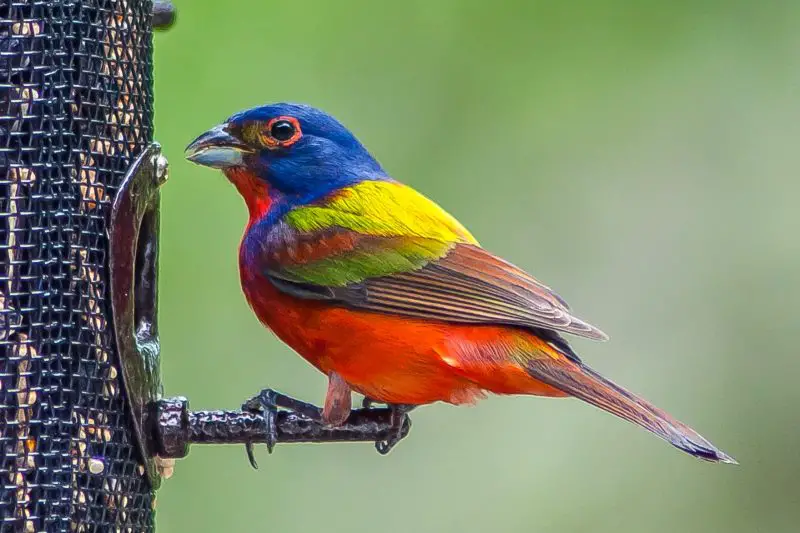
A Colorful Journey Spanning Continents
Despite their small size, Painted Buntings are long-distance travelers with epic seasonal journeys. Each year, these dazzling birds migrate over 1,000 miles to escape the cold. Eastern populations fly to southern Florida, Cuba, and other parts of the Caribbean, while their western cousins make their way to Mexico and Central America. Their annual migration is a bold voyage across forests, coastlines, and open skies—proof that even the most delicate creatures can endure incredible distances in search of warmth, food, and renewal.
6. They Prefer Dense, Shrubby Habitats
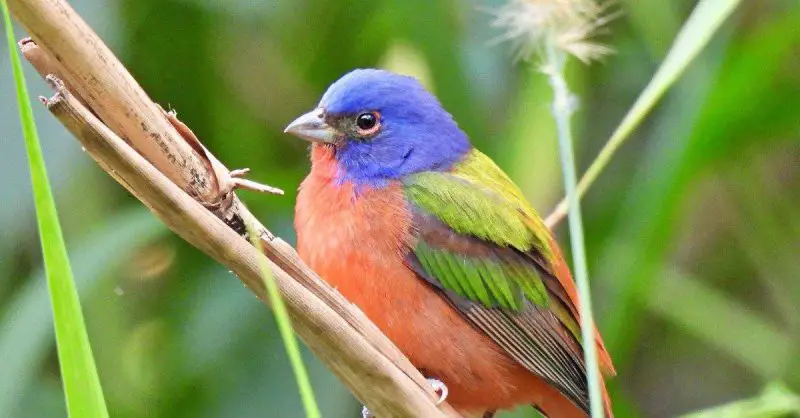
Masters of Disguise in the Green Maze
Painted Buntings aren’t birds that seek the spotlight—they thrive in the shadows of nature. Rather than perching in plain sight, these secretive songbirds hide deep within dense thickets, tangled shrubs, woodland edges, and overgrown fields. Their vibrant colors may dazzle in photos, but in real life, they’re surprisingly hard to spot. Their choice of habitat offers both food and protection, allowing them to forage quietly and raise their young in leafy seclusion. For birders, catching a glimpse often means peering carefully into the green maze.
7. Males Are Extremely Territorial
Brilliant Colors, Fierce Attitude
Don’t let their jewel-toned feathers fool you—male Painted Buntings are as fiery in spirit as they are in appearance. During the breeding season, these radiant songbirds turn into fierce defenders of their turf. A single male will vigorously guard his chosen territory, chasing away rivals and even harassing birds of other species that dare to cross the invisible boundary. Their bold behavior is driven by competition for mates and nesting space, turning quiet forest edges into battlegrounds alive with song, flashes of color, and mid-air skirmishes.
8. Their Song Is a Series of Musical Notes
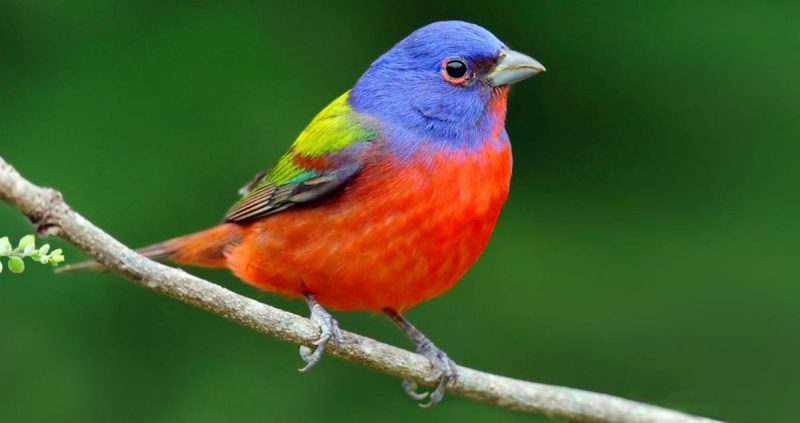
A Voice as Beautiful as Their Feathers
While their colors catch the eye, it’s their song that captures the heart. The male Painted Bunting sings a delicate, high-pitched series of musical phrases—bright, airy notes that seem to dance through the trees. These songs serve a double purpose: to attract a mate and to warn intruders that the territory is taken. Each male has his own unique variation, like a signature melody echoing through the brush. In the hush of early morning or the golden light of dusk, their voices turn thickets into hidden concert halls.
9. They Have a Unique Molting Process
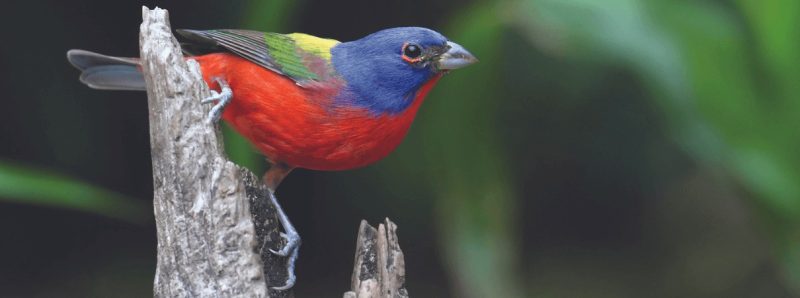
From Modest Green to Rainbow Majesty
Male Painted Buntings aren’t born with their dazzling colors—they have to earn them. In their first year of life, young males wear the same greenish plumage as females, a clever camouflage that helps them stay hidden from predators while they mature. Only after their first molt do they transform, replacing their leafy disguise with a breathtaking explosion of blue, red, and green. It’s a stunning reveal—a quiet bird suddenly becoming one of the most vivid creatures in the natural world.
10. They Feed on Seeds, Insects, and Berries
A Colorful Bird with a Seasonal Menu
Painted Buntings aren’t picky eaters—they adjust their diet with the changing seasons. In winter, they rely heavily on seeds, using their strong, conical beaks to crack open tough shells. Come spring and breeding season, their needs shift toward protein-rich insects and spiders to fuel nesting and raise hungry chicks. As summer fades into fall, they happily feast on berries and soft fruits, adding natural sweetness to their diet. This flexible feeding strategy helps them thrive in diverse habitats throughout the year.
11. They Are Cavity-Free Nesters
Hidden Cradles Among the Leaves
Unlike woodpeckers or bluebirds that nest in tree holes, Painted Buntings prefer open, leafy shelter. The female carefully builds a small, cup-shaped nest tucked deep within dense shrubs or low branches—so well concealed that even experienced birders often miss them. Made from grasses, roots, and cobwebs, these nests are sturdy yet delicate. Once complete, the female takes on the primary role of incubating the eggs, quietly nurturing life in nature’s hidden corners, far from the eyes of predators and people alike.
12. Their Populations Are Declining
Brilliance at Risk from Human Pressure
As breathtaking as they are, Painted Buntings are facing a quiet crisis. Though protected by law in the United States, their numbers are dwindling due to ongoing habitat destruction—especially in coastal areas and overgrown farmlands where they breed. Even more troubling is the illegal trapping of these birds for the pet trade, particularly in parts of Latin America, where their vivid colors make them highly sought-after.
Each trapped or displaced bunting is a piece of wild beauty stolen from its rightful place in nature. Conservation groups are now stepping in, tracking populations, preserving critical habitats, and working with local communities to end illegal capture. But the fight to protect this living rainbow is far from over.
13. They May Visit Backyard Feeders
A Rare Gem at the Feeder—If You’re Lucky
For bird lovers in the Southeast and Texas, there’s always a chance—however slim—that a Painted Bunting might grace your backyard. These shy beauties are occasionally drawn to quiet, well-planted spaces that offer dense cover and a steady supply of white millet. A brushy corner, native shrubs, and minimal disturbance can turn your yard into a miniature sanctuary.
But don’t expect a bold arrival. Painted Buntings are notoriously elusive and may visit feeders only briefly and cautiously, often darting away at the slightest movement. Catching a glimpse of one in your own garden is a moment birders treasure—like spotting a rainbow that lands, if only for a heartbeat.
14. They Are a Top Target for Birdwatchers
A Bucket-List Bird Worth the Wait
Among birdwatchers, the Painted Bunting holds near-mythic status. Its combination of rarity, vibrant colors, and secretive behavior makes spotting one a dream come true. For many, seeing a male in full breeding plumage—radiating red, green, and blue like a living jewel—is the highlight of a lifetime of birding adventures.
Entire trips are planned around the chance to catch a glimpse of this elusive species in its natural habitat. When one finally appears, even briefly, the excitement is electric. It’s not just another bird—it’s a feathered masterpiece, and a reward for patience, persistence, and passion.
15. Their Name Has Artistic Origins
A Bird So Colorful, It Sounds Like Myth
The name “Painted Bunting” isn’t poetic exaggeration—it’s pure truth. With feathers that seem brushed on by an artist’s hand, this bird looks like a canvas come to life. Its colors are so vivid and improbable that early naturalists could scarcely believe such a creature existed.
Even its scientific name, Passerina ciris, hints at its mythic aura. “Ciris” refers to a figure from Greek mythology—a girl transformed into a brightly colored bird. It’s a fitting tribute to a species that seems touched by legend, living proof that nature sometimes outdoes even the wildest imagination.
Final Thoughts: A Bird Worth Protecting
Painted Buntings are more than just beautiful—they are a vibrant part of North America’s biodiversity. Their beauty is matched by fascinating behaviors, a complex migration pattern, and the challenges they face in a changing world. By learning more about them and supporting habitat preservation, we help ensure that future generations can continue to marvel at this living jewel of the bird world.






